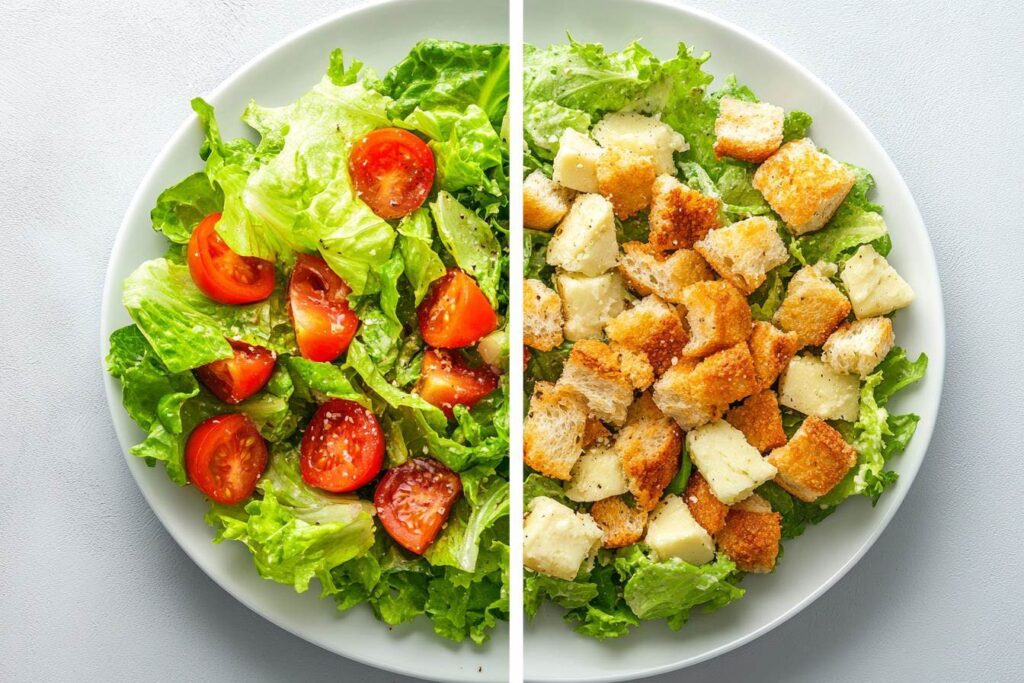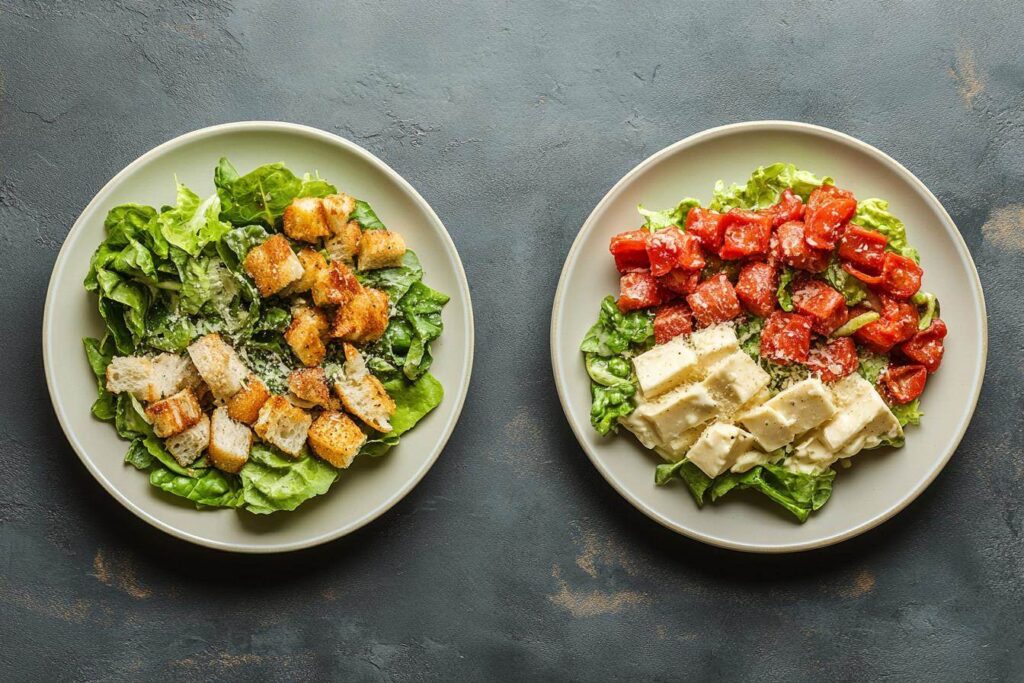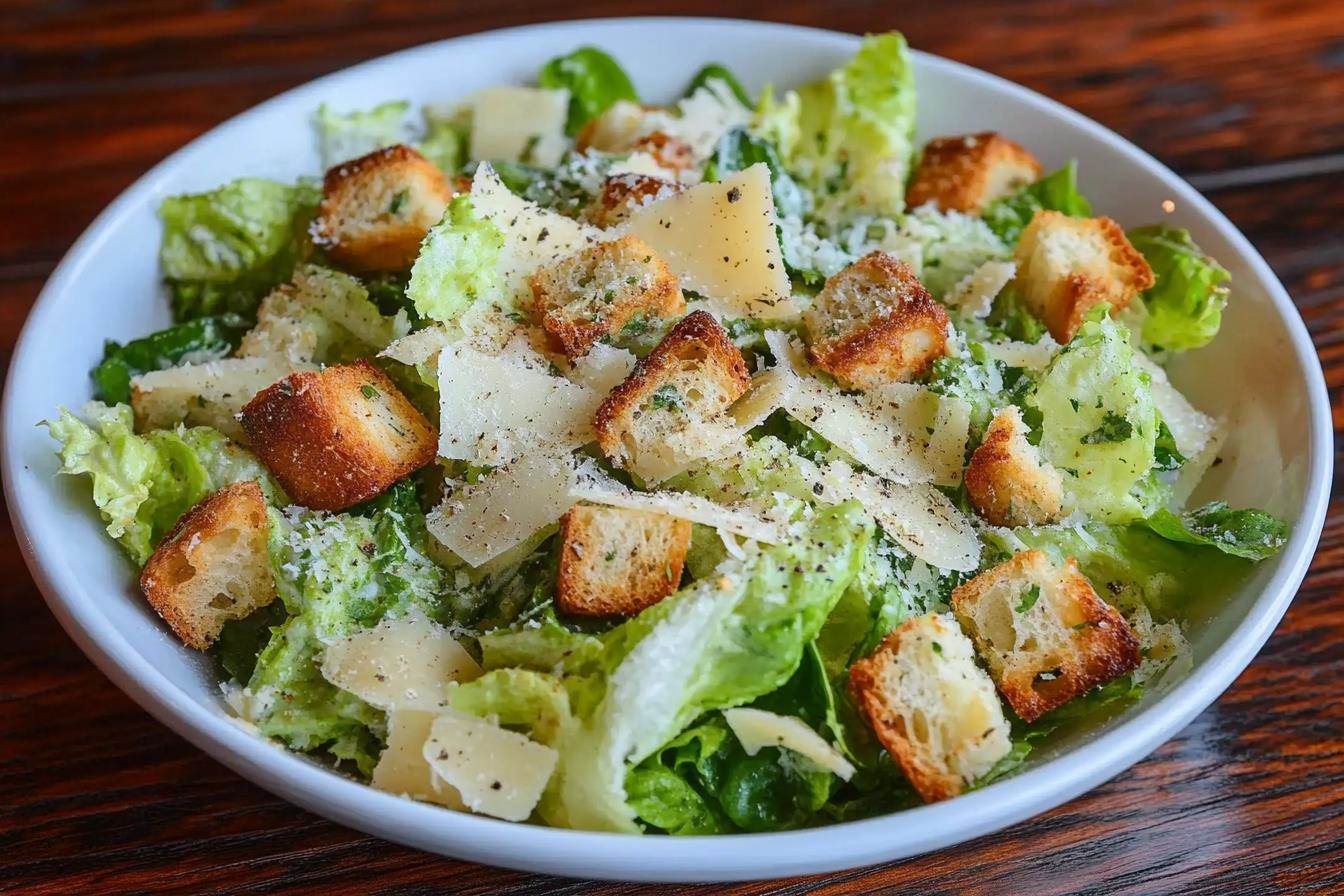When it comes to salads, the Caesar variety holds a special place in people’s hearts—and on their plates. Known for its creamy dressing, crunchy croutons, and a sprinkle of Parmesan, the Caesar salad is a staple at restaurants and dinner tables alike. But is this beloved dish as healthy as it seems? In this article, we’ll explore whether a Caesar salad is still healthy, diving into its nutritional composition, potential risks, and tips for making it a more balanced choice.
Let’s start by understanding its roots and the controversy surrounding its healthiness.
Introduction to Caesar Salad
Origins and Popularity of Caesar Salad
The Caesar salad’s story is as iconic as its taste. Created in the 1920s by Caesar Cardini, an Italian chef working in Tijuana, Mexico, this dish became a culinary sensation almost overnight. The simplicity of its ingredients—romaine lettuce, croutons, cheese, and a tangy dressing—resonated with diners, making it a classic that has endured for decades. Today, Caesar salads are found in nearly every corner of the globe, from upscale bistros to fast-food chains.
Key Ingredients in a Classic Caesar Salad
At its core, a traditional Caesar salad contains:
- Fresh romaine lettuce as the base.
- Crunchy croutons, often fried or buttered.
- Grated Parmesan cheese for its savory, umami kick.
- Caesar dressing, made with olive oil, egg yolks, anchovies, lemon juice, Dijon mustard, and garlic.
These ingredients work harmoniously to deliver that signature rich and tangy flavor. However, the very elements that make it irresistible—such as the dressing and croutons—also raise questions about its health value.
Why Caesar Salad’s Healthiness Is Debated
Although it features a leafy green foundation, Caesar salad’s reputation as a healthy choice is often debated. That’s because the calorie count, fat content, and sodium levels can be surprisingly high, especially in restaurant versions. On the flip side, romaine lettuce provides essential vitamins and hydration, and anchovies contribute omega-3 fatty acids. This dichotomy makes it essential to scrutinize the dish’s nutritional profile to answer the pressing question: Is a Caesar salad still healthy?
Nutritional Analysis of a Classic Caesar Salad
Calories, Fat, and Sodium Content
When considering Is a Caesar salad still healthy?, the numbers often tell the story. A typical Caesar salad, especially the restaurant-sized entrée version, can pack a caloric punch. Depending on the preparation, a single serving might range from 300 to over 1,200 calories. The dressing, usually made with egg yolks and oil, contributes most of the fat—up to 20 grams or more per serving. Sodium content is another red flag, with some salads containing as much as 70% of the daily recommended intake.
For example, a Caesar salad from a popular restaurant chain might include 1,270 calories, 112 grams of fat, and 1,630 milligrams of sodium—numbers that rival those of a fast-food burger.

Nutritional Benefits of Romaine Lettuce
Despite the calorie concerns, romaine lettuce remains the salad’s saving grace. As a base, it provides fiber, which aids digestion, and an array of vitamins like A, C, and K. Plus, its high water content helps with hydration. While the lettuce is low in calories, the added ingredients, like croutons and cheese, tip the scales.
Role of Key Ingredients: Parmesan, Dressing, and Croutons
Parmesan cheese delivers a rich umami flavor but also contributes saturated fat and sodium. Meanwhile, croutons—often fried—add crunch but come with refined carbs and unhealthy fats. The creamy dressing, the signature element, is a double-edged sword, offering omega-3s from anchovies and olive oil but offset by its high calorie and fat content.
By now, it’s clear that while Caesar salads have redeeming qualities, their nutritional downsides can’t be ignored.
Health Risks Associated with Caesar Salad
High Sodium Content and Its Implications
One major concern with Caesar salad is its sodium load. A high-sodium diet can lead to water retention, increased blood pressure, and long-term cardiovascular risks. The dressing and Parmesan cheese are the main culprits, often pushing the sodium content beyond 1,500 milligrams per serving. For those with hypertension or heart conditions, this is a red flag.
Excessive Calories in Restaurant Versions
Many assume salads are inherently healthy, but a Caesar salad can be a caloric trap. The fried croutons, heavy dressing, and generous cheese portions in restaurant salads elevate calorie counts. Eating these versions regularly might lead to weight gain or hinder efforts at a balanced diet.
Impact of Saturated Fats and Cholesterol
Saturated fats in Caesar salad come from Parmesan cheese, croutons, and the dressing. While small amounts of saturated fats are acceptable, excessive consumption can elevate LDL cholesterol levels, increasing the risk of heart disease. Egg yolks in the dressing also add dietary cholesterol, which may be problematic for individuals with specific health conditions.
To explore how Caesar salad can be part of a balanced meal, check out What Goes Well with Caesar Salad.
Health Benefits of Caesar Salad
Nutrients in Olive Oil, Lemon Juice, and Anchovies
Although Caesar salad has its challenges, it isn’t all bad news. The olive oil in the dressing is a great source of monounsaturated fats, which are known to support heart health. Lemon juice adds a refreshing zing while offering vitamin C, a powerful antioxidant that boosts the immune system. Anchovies, an often-overlooked ingredient, bring omega-3 fatty acids to the table. These healthy fats are essential for brain function and reducing inflammation.
Vitamins and Hydration from Romaine Lettuce
The romaine lettuce base is one of the healthiest components of a Caesar salad. This leafy green is rich in vitamins A, C, and K, which support skin health, immunity, and blood clotting. Its high water content contributes to hydration, especially when paired with other fresh ingredients.
Balanced Consumption and Portion Control
When consumed in moderation, a Caesar salad can be part of a balanced diet. Portion control is key—smaller servings of dressing and cheese can significantly reduce calorie and fat intake. By focusing on the nutrient-dense ingredients, you can enjoy the flavors you love without guilt.
How to Make Caesar Salad Healthier
Modifying the Dressing: Light and Homemade Options
One of the easiest ways to answer Is a Caesar salad still healthy? with a yes is by making your own dressing. Opt for lighter recipes that use Greek yogurt or avocado instead of egg yolks and heavy oil. You can also reduce sodium by using low-sodium anchovy paste or skipping it entirely. For store-bought options, look for light dressings labeled as low-fat or reduced sodium.

Replacing or Enhancing Croutons for Better Nutrition
Traditional croutons are often fried and made from refined bread. Swap these out for baked, whole-grain croutons to add fiber. Better yet, replace croutons altogether with roasted chickpeas or nuts for added crunch and protein. These alternatives keep the salad satisfying while being more nutritious.
Adding Vegetables for More Fiber and Vitamins
Turn your Caesar salad into a nutrient powerhouse by adding extra vegetables like cherry tomatoes, cucumbers, or bell peppers. These colorful additions not only increase the fiber and vitamin content but also add freshness and crunch.
Protein Boosters: Chickpeas, Grilled Chicken, or Tofu
Adding lean protein to your Caesar salad can make it a complete meal. Grilled chicken is a classic option, but roasted chickpeas or marinated tofu work well for vegetarians. These proteins enhance satiety without adding excessive fat or calories.
For more recipe inspiration, check out Caesar Pasta Salad Recipe for a unique twist on this classic dish.
With a few simple tweaks, your Caesar salad can go from indulgent to wholesome in no time!
Comparing Homemade vs. Restaurant Caesar Salad
Control Over Ingredients in Homemade Variations
Homemade Caesar salad gives you complete control over what goes into your dish. By using fresh ingredients, you can create a healthier version with fewer calories and less sodium. For instance, you can opt for a light dressing, whole-grain croutons, and a moderate sprinkle of Parmesan cheese. You also have the freedom to experiment with plant-based proteins or additional vegetables, tailoring it to your preferences and dietary needs.
Making it at home ensures you avoid preservatives and excess fats commonly found in restaurant salads. With careful preparation, is a Caesar salad still healthy? Absolutely, when you make it yourself!

Common Additives and Caloric Surprises in Restaurant Options
Restaurant Caesar salads, on the other hand, often include hidden calories. Large servings, heavy-handed dressing, and fried croutons are standard in most establishments. Some recipes even feature bacon or extra cheese, adding more fat and sodium. While these additions enhance flavor, they turn a seemingly light meal into a high-calorie indulgence.
Additionally, restaurant portions are usually larger than necessary, leading to overconsumption. If you’re dining out, consider asking for the dressing on the side or sharing a salad to manage your intake.
Additional Tips for Caesar Salad Lovers
Creative Ways to Enjoy Caesar Salad
For those looking to switch things up, consider adding grilled shrimp, roasted sweet potatoes, or quinoa to your Caesar salad for added flavor and nutrients. These ingredients bring a satisfying twist while enhancing the meal’s overall health profile.
When to Indulge in the Classic Version
Of course, there’s room for indulgence! Enjoy a traditional Caesar salad as an occasional treat, pairing it with lighter sides like a vegetable soup or fresh fruit to balance out the meal.
For a unique spin, check out the Caesar Pasta Salad Recipe for a blend of comfort and crunch.
In the end, whether you’re enjoying a classic Caesar salad or a healthier version, the key is savoring it without overindulging. After all, life’s too short not to enjoy good food—even when you’re making healthier choices!
FAQs About Caesar Salad Healthiness
What Is the Healthiest Way to Enjoy Caesar Salad?
The healthiest way to enjoy Caesar salad is to make it at home with lighter ingredients. Use a low-fat or homemade dressing, add plenty of fresh vegetables, and swap croutons for roasted chickpeas or nuts.
Can Caesar Salad Fit Into a Weight Loss Diet?
Yes, it can! By reducing the portion size and opting for low-calorie dressings, Caesar salad can be part of a weight loss diet. Adding lean proteins like grilled chicken or tofu makes it even more filling.
Are There Vegan or Dairy-Free Caesar Salad Options?
Absolutely. Vegan dressings made from cashews or tahini are great substitutes for traditional versions. Nutritional yeast can replace Parmesan, and roasted vegetables can add flavor and texture.
Is Caesar Salad Healthy Without Dressing?
Without dressing, Caesar salad becomes a low-calorie option packed with fiber and vitamins. However, for flavor, consider a drizzle of olive oil and lemon juice as a healthier alternative.
These tips prove that is a Caesar salad still healthy? depends on how you make or modify it!
Conclusion: Is Caesar Salad Still Healthy?
Balancing Taste and Health
When it comes to answering is a Caesar salad still healthy, the verdict lies in how it’s prepared. A classic Caesar salad has both strengths and weaknesses. On the one hand, its base of romaine lettuce provides hydration and vital nutrients. On the other, the calorie-laden dressing, croutons, and cheese can overshadow these benefits.
Final Thoughts on Making Better Choices
Ultimately, the healthiness of a Caesar salad is in your hands. By making small tweaks—like using a lighter dressing, adding more vegetables, and limiting portion sizes—you can enjoy this iconic dish guilt-free. Whether you’re making it at home or dining out, mindful decisions can turn Caesar salad into a nutritious and delicious choice. So next time you ask yourself, is a Caesar salad still healthy, remember that moderation and customization are key.

